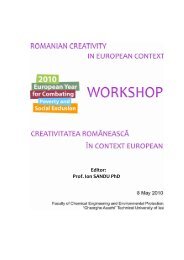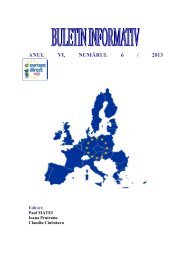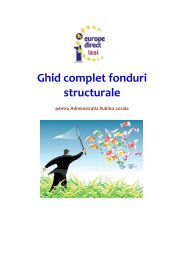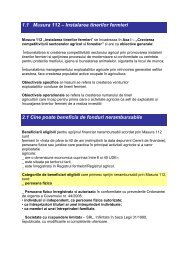eur op eanexhibitionofcreati vityandinnovation - Europe Direct Iasi
eur op eanexhibitionofcreati vityandinnovation - Europe Direct Iasi
eur op eanexhibitionofcreati vityandinnovation - Europe Direct Iasi
Create successful ePaper yourself
Turn your PDF publications into a flip-book with our unique Google optimized e-Paper software.
EUROINVENT 2013<br />
27.5<br />
Title EN<br />
Authors<br />
Institution<br />
Description<br />
EN<br />
Class no.<br />
Fusarium strain identification in different wheat samples,<br />
collected from different regions from the West part of<br />
Romania<br />
P<strong>op</strong>escu Sorina, Botau Dorica, Alexa Ersilia, Boldura Oana<br />
Maria, Negrea Monica, Bozac Petru<br />
Banat’s University of Agricultural Science and<br />
Veterinary Medicine from Timisoara<br />
In Romania as well as worldwide, Fusarium head blight<br />
(FHB), also known as scab, is a devastating disease of small<br />
grains causing serious yield losses and low grain quality.<br />
The disease commonly occurs in wheat, barley, rye and less<br />
in oats. The main causal agents of FHB in Eur<strong>op</strong>e are<br />
Fusarium graminearum and Fusarium culmorum, but<br />
Fusarium proliferatum or Fusarium verticiliodes could be<br />
also present. Although FHB may cause wheat yield losses,<br />
the interest in FHB is primarily fuelled by the ability of<br />
Fusarium species to produce mycotoxins.<br />
The aim of this work was the Fusarium species identification<br />
based on molecular anaylisis as well as mycotoxin<br />
quantification, correlated with the climatic conditions.<br />
Among the wheat samples collected from Arad and Timis<br />
counties, 5 were totally free of Fusarium infection,<br />
2 samples were infected only with Fusarium graminearum, 5<br />
samples were infected with Fusarium culmorum, 5 samples<br />
were infected with both species, Fusarium graminearum and<br />
Fusarium culmorum. Taking in account the chemotype, 4<br />
samples were infected with DON chemotype, 1 sample was<br />
infected with NIV chemotype and 7 samples contained both<br />
DON and NIV chemotype.<br />
Applications agriculture, food industry<br />
Innovative Researches<br />
NATIONAL<br />
189
















